Abstract
The distributions of the partial pressure of carbon dioxide (pCO2) and total alkalinity (TA) were examined for a 6-month period in the Wailuku and Wailoa rivers and coastal waters of Hilo Bay on the west coast of the Island of Hawaii, USA. Main results for the largest and turbulent Wailuku River show in the watershed an oversaturation in CO2 with respect to atmospheric equilibrium and a CO2 undersaturation in the estuary. In the Wailoa river-estuary system, extremely high pCO2 values ranging from 1500 to 10500 ppm were measured with significant shifts in pCO2 from drought to flood period. In the two rivers, water residence time, groundwater inputs and occasional flood events are the predominant drivers of the spatial and temporal patterns in the distribution of pCO2. In Hilo Bay, CO2 oversaturation dominates and the bay was a source of CO2 to the atmosphere during the study period. TA is conservative along the salinity gradient, indicating calcification in the bay is not a significant source of CO2 to the atmosphere.










Similar content being viewed by others
References
Abril G, Etcheber H, Borges AV, Frankignoulle M (2000) Excess atmospheric carbon dioxide transported into the Scheldt estuary. Compte Rendus de l’Académie des Sciences de Paris, Sciences de la Terre et des planètes 330:761–768
Abril G, Borges AV (2004) Carbon dioxide and methane emissions from estuaries: Berlin, Springer. In: Tremblay A, Varfalvy L, Roehm C, Garneau M (eds) Greenhouse gases emissions from natural environments and hydroelectric reservoirs: Fluxes and processes. Springer, Berlin, Heidelberg, New York, pp 187–207
Atekwana EA, Krishnamurthy RV (1998) Seasonal variations of dissolved inorganic carbon and C of surface waters: application of a modified gas evolution technique. J Hydrol 205:265–278
Barth JAC, Veizer J (1999) Carbon cycle in St. Lawrence aquatic ecosystems at Cornwall Ontario, Canada: seasonal and spatial variations. Chem Geol 159:107–128
Bates NR, Samuels L, Merlivat L (2001) Biogeochemical and physical factors influencing seawater fCO2, and air–sea CO2 exchange on the Bermuda coral reef. Limnol Oceanogr 46:833–846
Borges AV (2005) Do we have enough pieces of the jigsaw to integrate CO2 fluxes in the coastal ocean. Estuaries 28:1–25
Borges A, Djenedi S, Lacroix G, Theate J-M, Delille B, Frankignoulle M (2003) Atmospheric CO2 flux from mangrove surrounding waters. Geophys Res Lett 30(11):1558, doi:10.1029/2003GL017143
Borges AV, Delille B, Frankignoulle M (2005) Budgeting sinks and sources of CO2 in the coastal ocean: diversity of ecosystems counts. Geophys Res Lett 32(14):L14601, doi:10.1029/2005GL023053
Bouillon S, Frankignoulle M, Dehairs F, Velimorov B, Eiler A, Abril G, Etchebe H, Borges AV (2003) Inorganic and organic carbon biogeochemistry in the Gautami Godavari estuary (Andhra Pradesh, India) during pre-monsoon: the local impact of extensive mangrove forests. Global Biogeochem Cycles 17(4):1114, doi:10.1029/2002GB002026
Brady PV, Dorn RI, Brazel AJ, Clarck J, Moore RB, Glidewell T (1999) Direct measurement of the combined effects of lichen, rainfall, and temperature on silicate weathering. Geochim Cosmochim Acta 63:3293–3300
Cai WJ, Wang Y (1998) The chemistry, fluxes, and sources of carbon dioxide in the estuarine waters of the Satilla and Altamaha rivers, Georgia. Limnol Oceanogr 43:657–668
Cai W-J (2003) Riverine inorganic carbon flux and rate of biological uptake in the Mississippi River plume. Geophys Res Lett 30(2):1032, doi:10.1029/2002GL016312
Cai WJ, Wang AZ, Wang Y (2003a) The biogeochemistry of inorganic carbon and nutrients in the Pearl River estuary and the adjacent Northern South China Sea. Continental Shelf Res 24:1301–1319
Cai WJ, Wang Y, Krest J, Moore WS (2003b) The geochemistry of dissolved inorganic carbon in a surficial groundwater aquifer in North Inlet, South Carolina, and the carbon fluxes to the coastal ocean. Geochem Cosmochim Acta 67:631–637
Cole JJ, Caraco NF, Kling GW, Kratz TK (1994) Carbon dioxide supersaturation in the surface waters of lakes. Science 265:1568–1570
Cole JJ, Caraco NF (2001) Carbon in catchments: connecting terrestrial carbon losses with aquatic metabolism. Mar Freshw Res 52:101–110
Dessert C, Dupré B, Gaillardet J, Francois LM, Allègre CJ (2003) Basalt weathering and the impact of basalt weathering on the global carbon cycle. Chem Geol 202:257–273
Fagan K, Mackenzie FT (2006) Air–sea CO2 exchange in a sub-tropical estuarine/coral reefs systems, Kaneohe Bay, Hawaii, Oahu, USA. Mar Chem (in press)
Frankignoulle M, Abril G, Borges AV, Bourge I, Canon C, Delille B, Libert E, Théate J-M (1998) Carbon dioxide emission from European estuaries. Science 282:434–436
Frankignoulle M, Gattuso J-P, Biondo R, Bourge I, Copin-Montégut G, Pichon M (1996a) Carbon fluxes in coral reefs. II. Eulerian study of inorganic carbon dynamics and measurement of air–sea CO2 exchanges. Mar Ecol Prog Ser 145:123–132
Frankignoulle M, Bourge I, Wollast R (1996b) Atmospheric CO2 fluxes in a highly polluted estuary (The Scheldt). Limnol Oceanogr 41:365–369
Garrels RM, Mackenzie FT (1971) Evolution of sedimentary rocks New York. W. W. and Company, Norton, 397 pp
Gattuso J-P, Pichon M, Delesalle B, Frankignoulle F (1993) Community metabolism and air–sea CO2 fluxes in a coral reef ecosystem (Moorea, French Polynesia). Mar Ecol Prog Ser 96:2567–2579
Gran G (1952) Determination of the equivalence point in potentiometric titrations. Part II. Analysis 77:661–671
Helie J-F, Hillaire-Marcel C, Rondeau B (2002) Seasonal changes in the sources and fluxes of dissolved inorganic carbon through the St. Lawrence River-isotopic and chemical constraint. Chem Geol 186:117–138
Herman PMJ, Heip CHR (1999) Biogeochemistry of the MAximum TURbidity Zone of Estuaries MATURE. J Mar Syst 22:89–104
Ito RG, Schneider B, Thomas H (2005) Seasonal variations of fCO2 in seawater of the southwestern subtropical Atlantic and adjacent continental shelf. J Mar Syst 56:227–242
Jones JJB, Mulholland PJ (1998) Carbon dioxide variation in a hardwood forest stream: An integrative measure of whole catchment soil respiration. Ecosystems 1:183–196
Jones JJB, Stanley EH, Mulholland PJ (2003) Long-term decline in carbon dioxide supersaturation in rivers across the contiguous United States. Geophys Res Lett 30(10):1495, doi:10.1029/2003GL017056
Kempe S, Pettine M, Cauwet G (1991) Biogeochemistry of Europe rivers. In: Degens ET, Kempe S, Richey JE (eds) Biogeochemistry of Major World Rivers, SCOPE 42. John Wiley & Sons, New York N.K., pp 169–211
Kling GW, Kipphut GW, Miller MC (1991) Arctic lakes and streams as gas conduits to the atmosphere: Implications for tundra carbon budgets. Science 251:298–301
Li Y-H (1988) Denudations rates of the Hawaiian islands by rivers and groundwaters. Pacific Sci 42:253–266
Ludwig W, Probst JL, Kempe S (1996) Predicting the oceanic input of organic carbon by continental erosion. Global Biogeochem Cycles 10:23–42
Mackenzie FT, Lerman A, Andersson AJ (2004) Past and present of sediment and carbon biogeochemical cycling models. Biogeosci Discussions 1:11–32, http://www.biogeosciences.net/bgd/1/27/
Mehrbach C, Culberson CH, Hawley JE, Pytkowicz RM (1973) Measurements of the apparent dissociation constants of carbonic acid in seawater at atmospheric pressure. Limnol Oceanogr 18:897–907
Meybeck M, Helmer R (1989) The quality of rivers: from pristine stage to global pollution, Palaeogeography, Palaeoclimatology. Palaeoecology 75:283–309
Milliman JD, Farnsworth KL, Albertin CS (1999) Flux and fate of fluvial sediments leaving large islands in the East Indies. J Sea Res 41:97–107
Mukhopadhyay SK, Biswas H, De TK, Sen S, Jana TK (2002) Seasonal effects on the air–water carbon dioxide exchange in the Hooghly estuary, NE coast of Gulf of Bengal, India. J Environ Monitor 4:549–552
Raymond PA, Bauer JE, Cole JJ (2000) Atmospheric CO2 evasion dissolved inorganic carbon production, and net heterotrophy in the York estuary. Limnol Oceanogr 45:1707–1717
Regnier P, Steefel CI (1999) A high resolution estimate of the inorganic nitrogen flux from the Scheldt estuary to the coastal North Sea during a nitrogen-limited algal bloom, spring 1995. Geochem Cosmochim Acta 63:1359–1374
Richey JE, Melack JM, Aufdenkampe AK, Ballester VM, Hess LL (2002) Outgassing from Amazonian rivers as wetlands as a large tropical source of atmospheric CO2. Nature 416:617–620
Sabine CL, Feely RA, Gruber N, Key RM, Bullister L, Wanninkhof R, Wong CS, Wallace DWR, Tilbrook B, Millero FJ, Peng T-H, Kozyr A, Ono T, Rios AF (2004) The oceanic sink for anthropogenic CO2. Science 305:367–371
Sarma VVSS, Kumar MD, Manerikar M (2001) Emission of carbon dioxide from a tropical estuarine system, Goa, India. Geophy Res Lett 28(7):1239–1242, doi:10.1029/2000GL006114
Sehmi K (1996) Erosion et transfert de matière sur le basin versant de la Garonne, influence de la sécheresse, thèse. Université Louis-Pasteur, Strasbourg, 203 pp
Stewart BW, Capo RC, Chadwick OA (2001) Effects of rainfall on weathering rate, cation provenance, and Sr isotope composition of Hawaiian soils. Geochim Cosmochim Acta 5:1087–1099
Telmer K, Veizer J (1999) Carbon fluxes, pCO2 and substrate weathering in a large northern river basin, Canada: carbon isotope perspectives. Chem Geol 159:61–86
Ternon JF, Oudot C, Dessier A, Diverres D (2000) A seasonal tropical sink for atmospheric CO2 in the Atlantic ocean: the role of the Amazon River discharge. Mar Chem 68:183–201
Weiss RF (1974) Carbon dioxide in water and seawater: the solubility of a non-ideal gas. Mar Chem 2:203–215
Wollast R (1988) The Scheldt estuary. In: Salomons W, Bayne BL, Duursma EK, Forstner U (eds) Pollution of the North Sea, an assessment. Springer, Berlin, pp 183–193
Yee JJS, Ewart CJ (1986) Biological, morphological, and chemical characteristics of Wailuku River. U.S. Geological Survey Water-Resources Investigations Report, Hawaii, pp 85–4285, 64 p
Zhai W, Dai M, Cai W-J, Wang Y, Hong H (2005) The partial pressure of carbon dioxide and air–sea fluxes in the northern South China Sea in spring, summer and autumn. Mar Chem 96:87–97
Acknowledgements
We thank the Program in Marine Science at the University of Hawaii at Hilo for their support of FSP while he was student and for providing office space to FTM while he was a Visiting Professor there. We gratefully acknowledge the National Science Foundation (EAR02-23509), the Hawaii Sea Grant Program and B. L. Heintz, and V. J. Jacinto for their financial support for this research. AVB is a research associate at the Fonds National de la Recherche Scientifique. This is SOEST contribution no. XXX. MARE contribution no. XXX.
Author information
Authors and Affiliations
Corresponding author
Rights and permissions
About this article
Cite this article
Paquay, F.S., Mackenzie, F.T. & Borges, A.V. Carbon dioxide dynamics in rivers and coastal waters of the “big island” of Hawaii, USA, during baseline and heavy rain conditions. Aquat Geochem 13, 1–18 (2007). https://doi.org/10.1007/s10498-006-9005-5
Received:
Accepted:
Published:
Issue Date:
DOI: https://doi.org/10.1007/s10498-006-9005-5




